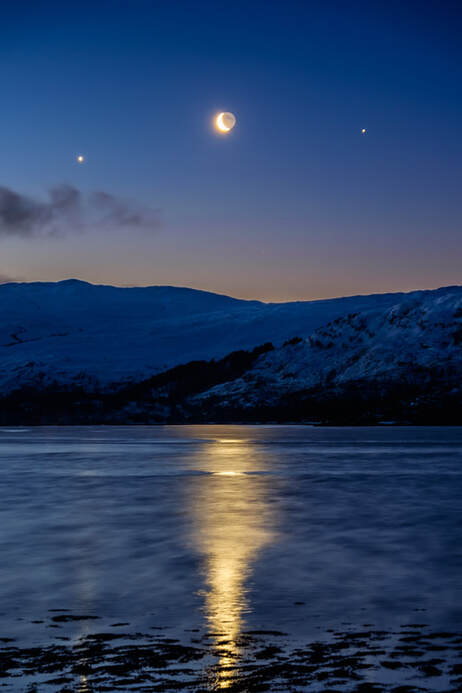|
From early July to late September, we have been treated to the sight of four full supermoons rising in the east at sunset and with two full supermoons happening in August, much was made of them on the television and radio and in the newspapers. In addition, social media was full of people’s photographs of what were truly magnificent spectacles. However, something that we hear a lot less of is the rising or setting of a crescent moon which, in my opinion, is a far more beautiful and beguiling sight and one that has deep symbolic significance in various cultures and spiritual traditions around the World The beauty of a crescent moon is very subjective and is very much down to personal preference, but I do find it particularly captivating when the Moon is visible at sunset or sunrise. This timing allows a crescent moon to appear against the backdrop of the colourful twilight sky and create a striking visual contrast just like it did on the evening when I took this month’s photograph. I was absolutely captivated by the sight of it hanging in the sky just above the hills of Morvern and the orange glow from a setting Sun.
This captivating and beautiful celestial sight has been historically associated with various myths and cultural beliefs and predominant themes seem to be ones of renewal and transformation. In various religious contexts, a crescent moon holds specific meanings. In some pagan and Wiccan traditions, the crescent moon is considered a symbol of the feminine divine, representing cycles, intuition, and the ever-changing nature of life, while in Hinduism, it is associated with various deities, including Shiva and Parvati and the waxing and waning of the Moon is said to represent the cycle of life, death, and rebirth. However, it is in Islam where the crescent moon perhaps features most prominently and is seen on top of minarets and mosques, and on the flags of many Muslim countries. Representing the beginning of the lunar month, it is used to determine the timing of important Islamic events and holidays, such as Ramadan, the ninth month of the Islamic lunar calendar. This month is a time of fasting, prayer, reflection, and community for Muslims worldwide and the crescent moon plays a crucial role at its beginning and end. The sighting of the new crescent moon marks the end of the month of Sha'ban and the beginning of Ramadan, while the sighting of the crescent moon at the end of Ramadan signifies the end of the fasting period and the celebration of Eid al-Fitr, a festival that marks the end of Ramadan. Given how captivating the sight of a crescent moon can be, it is perhaps little wonder that it plays a role in several of the World’s cultures and religions, but whatever your beliefs are, it is certainly a sight worth seeing. So, if you are an early riser, look out for it in the east at sunrise on the mornings just before a new moon and if you are a night owl, look for it in the west at sunset a few days later. You won’t be disappointed.
4 Comments
Sherry Falconer MONSON
15/11/2023 19:05:09
A calendar of these would be wonderful - "daylight" ones for the summer months and darker through to Jan/Dec... just a thought as they are fabulously dramatic. I´d buy at LEAST one (for me)!!! Meet you eventually!!
Reply
4/12/2023 14:41:17
Hi Sherry,
Reply
Jacqueline Love
15/11/2023 22:18:15
I really like,that you have a great knowledge of your subjects.
Reply
4/12/2023 14:42:53
Hi Jaqueline,
Reply
Your comment will be posted after it is approved.
Leave a Reply. |
AuthorHi, Archives
July 2024
Categories
All
|
Steven Marshall Photography, Rockpool House, Resipole, Strontian, Acharacle, PH36 4HX
Telephone: 01967 431 335 | Mobile: 07585 910 058 | Email: [email protected]
Telephone: 01967 431 335 | Mobile: 07585 910 058 | Email: [email protected]
All Images & Text Copyright © 2024 - Steven Marshall - All Rights Reserved




